| A selection of the projects I have worked on. The game industry cancels two-thirds of all the projects that it starts, so any developer who has been in the business as long as I have will have worked on a lot of things that never made it out the door. This page is divided into my published and unpublished games. I have 18 published titles (that I'm allowed to claim publicly) so far. I have
been a design consultant since 2000, so I have also worked on a large number of projects for private clients that aren't listed here. Published Games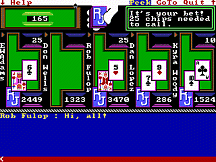 
| RabbitJack's Casino for IBM PC (1989–1991)This was
a suite of four on-line games for a network called PC-Link, which later became America Online. The games were blackjack, stud poker, bingo, and a slot machine. I wrote the PC-side client software. Now that these kinds of games are available free on the web, it's hard to imagine that people used to pay $6 an hour to play them! RabbitJack's Casino finally went off-line on October 2, 2000, disappointing legions of loyal fans, although I believe it may still be
possible to play bingo.
| 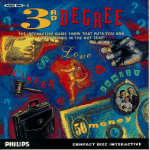 
| Third Degree for CD-I Player (1992)Third Degree
was a multiplayer party game for three to six people. Using voice-over narration and funny pictures, the game described an awkward social situation. If a player could accurately predict what another player would do in the situation, they both would get points. The game proceeded in three rounds, like a television game show. We hired a comedy writer to devise the script, and a photographer and a lot of improv actors to shoot the scenes. In the process we used one of the first-ever digital cameras, the $10,000 Sony Mavica, which saved the images on miniature floppy disks.
The picture at the left is from the "that movie you rented to watch with your mom turned out to be very explicit" dilemma.
| 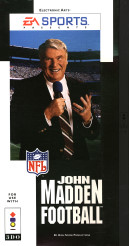
| John Madden Football for 3DO (1994)Madden for the 3DO was my first full-scale design to be released as a shipping product. Because of time constraints and problems with the hardware, a number of innovative features had to be cut late in the development process. It was also the first time that a Madden game was put on a CD, and to show off this capability we included a pre-game show and "Scouting Reports": video of John Madden commenting on the merits of each team. That experience led to my doing media design and video production on all the subsequent Madden games.
| 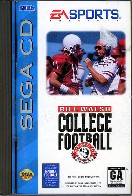
| Bill Walsh College Football for Sega CD (1995)College Football included some video clips of Coach Bill Walsh discussing the differences between the college and the professional game. I helped out with the post-production.
| 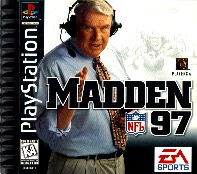
| Madden NFL 97 for Sony Playstation, IBM PC, and Sega Saturn (1996)Madden came back to the IBM PC for the first time in many years. To celebrate this we included a second CD called Madden University in the PC version, along with the now-traditional pre-game show on all platforms. Madden University consisted of classrooms for offense, defense, and special teams, and a library. In each of the classrooms John Madden lectured about tactics and strategy, and in the Library he analyzed the current teams. This required video for three
different platforms using three different compression codecs.
| 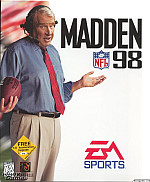
| Madden NFL 98 for Sony Playstation and IBM PC (1997)
I handled all the play-by-play and video clips in Madden 98 except for the opening cinematics. In this version of the game we introduced two new video features: Madden teaching about football formations and defensive alignments using the Telestrator, and narrated histories of most of the teams accompanied by historical footage. I did all the research and wrote the scripts for these elements.
| 
| Madden Football 64 for Nintendo 64 (1997)A subset of the audio play-by-play that
appeared in Madden 98 was also used for Madden 64. Since this was a cartridge game it didn't include any video. Notice that Madden 64 did not have an NFL license, although later versions for the Nintendo 64 did.
| 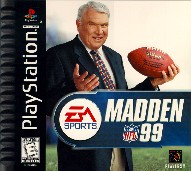
| Madden NFL 99 for Sony Playstation, Nintendo 64, and IBM PC (1998)Madden 99 expanded on Madden 98 with more play-by-play, and introduced a new feature called "Star Talk." This consists of Madden talking about specific star players in a context-appropriate way whenever one of them does something good in the game.We also completed the historical videos, including all teams, and re-recorded the Telestrator lectures using better quality backgrounds.
| 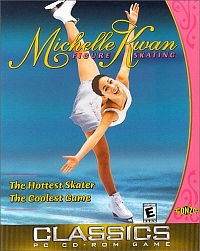
| Michelle Kwan Figure Skating for IBM PC (1999)I can't in all honesty
say that I helped to develop or even produce this game. What I did was to script, record, and edit a short movie to help the producer, Mitzi McGilvray, "sell" the idea to the Electronic Arts top brass. It was a pretty cool video, if I say so myself, and they did decide to publish the game. As far as I know, this was EA's first game aimed specifically at the female market — something I had been arguing for since 1995.
| 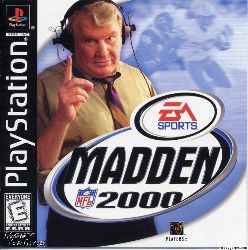
| Madden NFL 2000 for Sony Playstation, Nintendo 64, and IBM PC (1999)
The best Madden to date for a lot of reasons. This year I had a team of several people working on the voiceover scripts with me, and more importantly, I had a real professional to direct the audio recording session with Pat Summerall. The results were excellent. In addition, we added commentary while play was actually under way ("...drops back to pass...") which leant a great sense of immediacy to the sound. My only regret is that we had to reduce
the amount of video in the PC version significantly owing to cost considerations. I understand the reasoning, but I was sorry to see it go.
| Since 2000 I've been consulting and writing, so most of my work has been uncredited. Below are some of the projects I'm allowed to talk about. See the Consulting page and my Client List for more information.
| 
| Loophole
Loophole isn't a game but a Swedish brand of children's entertainment products including a highly successful TV show, comic books, and other merchandise. The show was such a hit that the main characters were even put on Swedish postage stamps! The line is developed by Hidden Entertainment, formerly Hidden Dinosaur, and I was brought in to consult at an early stage when they were considering building an MMOG.
| 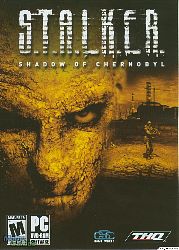
| S.T.A.L.K.E.R.: Shadow of Chernobyl for IBM PC (2007)THQ brought me in as a design consultant on this game in 2004, and I flew to Kiev to work with GSC Game World, the developers, for a while. Not many of my contributions are actually visible in the game -- they often consisted of recommendations to remove elements that didn't work, rather than to add new ones! However, the result is impressive, and I'm proud to have been credited (on-screen if not in the manual) with having helped bring S.T.A.L.K.E.R. to fruition.
| 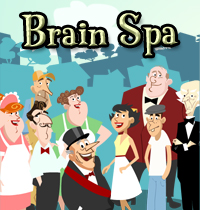
| Brain Spa for IBM PC (2007)Brain Spa is a downloadable casual game in the brain training genre. Legacy Interactive asked me to give them a hand with some of the mini-games. I made recommendations about the scoring system and the user interface, particularly in the "scrambled words" game.
| 
| EngleKræsj (Angel Crash) for IBM PC (2009)Angel Crash won the Best Action Game award at the 2009 Nordic Game Awards, and was also nominated for Best Artistic Achievement and Best Nordic Game. It's a cute nonviolent action game from Ravn Studios in Norway. I did a little design consulting for them. I can't claim any credit for the awards, but I'm always proud when I see my clients doing well.
In the game you play as two little angels who accidentally knocked all of Heaven's musical instruments off a cloud and down to Earth. Each angel has different powers. You have a variety of adventures on Earth retrieving the instruments.
| 
| Water Manager for IBM PC (2009)Water Manager is a serious game, a project funded by a collaboration between two Dutch water companies, Vitens and Evides, and the United Nations Educational, Scientific, and Cultural Organization (UNESCO). It was built by students at the Noordelijke Hogeschool Leeuwarden, where I act as a consultant and unofficial visiting professor.
The game is a multi-player simulation that teaches executives at a water company how to work together efficiently. (This turns out to be much more complicated than I had ever realized.) It's intended primarily for training people in developing nations such as Viet Nam and Mozambique, where Vitens and Evides export water management technology and know-how.
| 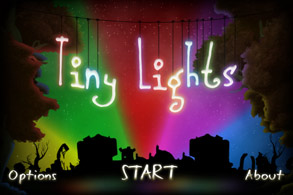
| Tiny Lights for iPhone (2011)This is a fun and imaginative role-playing/adventure game for the iPhone, made by
Darling Dash. They consulted me on the concept and early level designs.
| |
Andromeda Blue for Windows Phone (2014)A multiplayer isometric aerial combat game with RTS elements, made by Tuliotus. I gave them some thoughts on the game's introductory stages and balance.
| 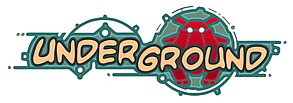
| Underground for Nintendo Wii and Wii U (2015)Underground is a single-player puzzle game about helping a little girl and her robot friends escape from a cave, using crane arms with a variety of tools to manipulate the environment. It's playable using the Wii U's analog joysticks, but with Wiimotes and specialized controllers, it has a stealth function too: it trains laparoscopic surgeons' motor skills!
|
Unpublished GamesLike most developers, I have designed or worked on several games that were never published. Takeover for IBM PC (1991)This was an on-line multiplayer stock market simulation designed for America On-line. It never went beyond the high-concept stage. The game was not based on the real stock market, but
instead simulated a small closed community, rather like board games do. One of its interesting features was that you could secretly plant or suppress stories in the newspaper to manipulate stock prices.
Dungeons & Dragons for the CD-I player (1991)This game was mocked up in a Hypercard stack for a presentation to American Interactive Media (later called Philips Interactive Media of America), which was funding most development for the CD
-I player. My friend Michael Becker did most of the Hypertalk programming and the artwork, and I wrote the back story. One of our challenges was to design a game that would present photorealistic images within the technical limitations of the CD-I player, whose CD drive only operated at normal (1X) speed. In the end we decided to do it by superimposing character sprites on photographed backdrops. We spent a lot of time looking at how sword fights were filmed in
movies to get the best perspective. AIM never obtained the D&D license from TSR, so the project never went any further.
Baseball '93 for IBM PC (1992)I was hired at Electronic Arts in the spring of 1992 as a software engineer. My task was to work on a successor to their highly successful Earl Weaver Baseball, using the same engine. Weaver was one of the most accurate baseball simulations ever seen, but it had a very poor front end. I was
supposed to replace the entire user interface with a new 3D engine, but retain the underlying simulation. The producer decided to cancel the project because the Sega Genesis promised to be much more lucrative, but on the strength of a design critique I had written, he asked me to become a game designer instead. I haven't done any software engineering since then.

| Wildfire! for IBM PC (1993)Wildfire! was a non-military real-time strategy game designed for Electronic Arts in the spring of 1993. The object of the game was to suppress forest fires. You took the role of the Incident Commander, deploying trucks, bulldozers, air tankers, smoke jumpers, and line crews to save lives and minimize property damage. The game was fully scripted, but never produced because the company was losing interest in PC games at the time.
| NO IMAGE AVAILABLE | Baseball for Sega Genesis CD (1995)I had a short stint designing a baseball game for the ill-fated Sega Genesis CD drive. Electronic Arts quickly recognized that the device wasn't going to be a
success, and dropped the project.
| 
| Madden NFL 96 for Sony Playstation and PC (1995)
This was one of Electronic Arts' most famous disasters. It was our first effort to develop for the Playstation. There were technical and management problems, and the game just got later and later until the company finally canceled it and started over with a new development team. Their work produced Madden NFL 97 in due course. My role on Madden NFL 96 was identical to that on all the subsequent Maddens, as the audio/video producer. My chief responsibility was writing and recording all the play-by-play and color broadcast commentary, as well as creating the video clips that introduced each team with real NFL footage and Madden's comments.
| 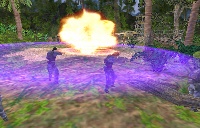
| Psychic Warriors for IBM PC (1998)This was a cooperative, squad-level 3D action game designed at Electronic Arts with my friend Jeff Haas in the autumn of 1998. An excellent prototype level was done by Black Ops, Inc., a Los Angeles developer. The basic idea was that a group of four DEA agents, each with special combat skills, are charged with investigating a mysterious new drug. As
their investigations take them back up the distribution chain, they begin to discover that some of their opponents are not human. They must learn to develop latent psychic powers to complement their combat abilities if they are to defeat this new supernatural threat. [Yes, I know it's corny, and there are definite echoes of Final Fantasy in it, but the basic idea was handed to us and it was up to us to put flesh on the bones.]
| 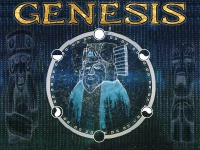
| Genesis: The Hand of God for IBM PC (1999)In August of 1999 I transferred from EA headquarters in Redwood City, California to the famous Bullfrog Productions in
Guildford, England. My task was to lead a prototype team in designing a new god game franchise in the spirit of the original Populous. Genesis: The Hand of God was the result. The game was about religious faith, evangelism, and warfare, and included a groundbreaking realtime 3D water simulation. It was very well received by the Bullfrog management, but it was an ambitious design and ultimately the company decided not to put it into full production.
| 
| Dungeon Keeper 3 for IBM PC (later retitled War for the Overworld) (2000)Following Genesis, I moved on to the
next game in the Dungeon Keeper line. This was to be an outdoor version of Dungeon Keeper, with castle-building taking the place of the tunnelling in earlier games. There were also unique hero characters and a new race. It would have been a sort of "role-playing strategy," combining elements of character management as well as warfare. Unfortunately, Bullfrog made a strategic decision not to create any more real-time strategy games of any sort, and Dungeon Keeper 3 was dead.
| NO IMAGE AVAILABLE | "Theme Movie Studio" (2000)My last project at Bullfrog Productions was to be the next game
in the Theme brand, and it would have been about running a movie studio. It never got past the concept stage, as EA killed off the Bullfrog brand. Lionhead actually came out with such a game, called The Movies, a few years later.
|
|